Deck 7: Efficiency, Exchange, and the Invisible Hand in Action
Question
Question
Question
Question
Question
Question
Question
Question
Question
Question
Question
Question
Question
Question
Question
Question
Question
Question
Question
Question
Question
Question
Question
Question
Question
Question
Question
Question
Question
Question
Question
Question
Question
Question
Question
Question
Question
Question
Question
Question
Question
Question
Question
Question
Question
Question
Question
Question
Question
Question
Question
Question
Question
Question
Question
Question
Question
Question
Question
Question
Question
Question
Question
Question
Question
Question
Question
Question
Question
Question
Question
Question
Question
Question
Question
Question
Question
Question
Question
Question

Unlock Deck
Sign up to unlock the cards in this deck!
Unlock Deck
Unlock Deck
1/159
Play
Full screen (f)
Deck 7: Efficiency, Exchange, and the Invisible Hand in Action
1
Economic profit is equal to:
A)accounting profit plus implicit costs.
B)total revenue minus accounting profit.
C)total revenue minus the sum of explicit and implicit costs.
D)accounting profit minus explicit costs.
A)accounting profit plus implicit costs.
B)total revenue minus accounting profit.
C)total revenue minus the sum of explicit and implicit costs.
D)accounting profit minus explicit costs.
total revenue minus the sum of explicit and implicit costs.
2
Which of the following is NOT an example of an explicit cost?
A)The overtime wages paid to workers.
B)The income the owner could have earned in his or her next best employment opportunity.
C)The salaries paid to the managers who help run the business.
D)The rent the owner pays each month to lease office space.
A)The overtime wages paid to workers.
B)The income the owner could have earned in his or her next best employment opportunity.
C)The salaries paid to the managers who help run the business.
D)The rent the owner pays each month to lease office space.
The income the owner could have earned in his or her next best employment opportunity.
3
Suppose you own a small business. Last month, your total revenue was $6,000. In addition, you paid:
$1,000 in monthly rent for office space,
$200 in monthly rent for equipment,
$3,000 to your workers in wages for the month, and
$1,000 for the supplies you used that month.
If you correctly determine that your economic profit last month was negative $200, then it must be true that:
A)you do not have any implicit costs.
B)your implicit costs are $200 per month.
C)your implicit costs are $1,000 per month.
D)the rent you pay on your equipment is an implicit cost.
$1,000 in monthly rent for office space,
$200 in monthly rent for equipment,
$3,000 to your workers in wages for the month, and
$1,000 for the supplies you used that month.
If you correctly determine that your economic profit last month was negative $200, then it must be true that:
A)you do not have any implicit costs.
B)your implicit costs are $200 per month.
C)your implicit costs are $1,000 per month.
D)the rent you pay on your equipment is an implicit cost.
your implicit costs are $1,000 per month.
4
Last year Christine worked as a consultant. She hired an administrative assistant for $15,000 per year and rented office space (utilities included)for $3,000 per month. Her total revenue for the year was $100,000. If Christine hadn't worked as a consultant, she would have worked at a real estate firm earning $40,000 a year. For Christine to earn a normal profit as a consultant, her accounting profit would have to be ________.
A)$51,000
B)$40,000
C)$9,000
D)$0
A)$51,000
B)$40,000
C)$9,000
D)$0

Unlock Deck
Unlock for access to all 159 flashcards in this deck.
Unlock Deck
k this deck
5
A firm earns a normal profit when its:
A)accounting profit is positive.
B)economic profit is positive.
C)economic profit is zero.
D)accounting profit is zero.
A)accounting profit is positive.
B)economic profit is positive.
C)economic profit is zero.
D)accounting profit is zero.

Unlock Deck
Unlock for access to all 159 flashcards in this deck.
Unlock Deck
k this deck
6
If a firm is earning zero economic profit, then:
A)the firm's revenues are sufficient to pay its explicit costs, but not its implicit costs.
B)the owner will not be able to pay himself or herself a salary.
C)the firm will shut down in the long run, but will continue to operate in the short run.
D)the firm's accounting profit is equal to the firm's implicit costs.
A)the firm's revenues are sufficient to pay its explicit costs, but not its implicit costs.
B)the owner will not be able to pay himself or herself a salary.
C)the firm will shut down in the long run, but will continue to operate in the short run.
D)the firm's accounting profit is equal to the firm's implicit costs.

Unlock Deck
Unlock for access to all 159 flashcards in this deck.
Unlock Deck
k this deck
7
Explicit costs:
A)measure the opportunity costs of the resources supplied by the firm's owners.
B)are fixed in the short run.
C)measure the payments made to the firm's factors of production.
D)are variable in the short run.
A)measure the opportunity costs of the resources supplied by the firm's owners.
B)are fixed in the short run.
C)measure the payments made to the firm's factors of production.
D)are variable in the short run.

Unlock Deck
Unlock for access to all 159 flashcards in this deck.
Unlock Deck
k this deck
8
If you were to start your own business, your implicit costs would include the:
A)rent that you have paid in advance for the use of a building.
B)opportunity cost of the time you spend working at the business.
C)profit you earn over and above your normal profit.
D)interest that you pay on your business loans.
A)rent that you have paid in advance for the use of a building.
B)opportunity cost of the time you spend working at the business.
C)profit you earn over and above your normal profit.
D)interest that you pay on your business loans.

Unlock Deck
Unlock for access to all 159 flashcards in this deck.
Unlock Deck
k this deck
9
Last year Christine worked as a consultant. She hired an administrative assistant for $15,000 per year and rented office space (utilities included)for $3,000 per month. Her total revenue for the year was $100,000. If Christine hadn't worked as a consultant, she would have worked at a real estate firm earning $40,000 a year. Christine's opportunity cost of working as a consultant last year was ________.
A)$15,000
B)$51,000
C)$40,000
D)$36,000
A)$15,000
B)$51,000
C)$40,000
D)$36,000

Unlock Deck
Unlock for access to all 159 flashcards in this deck.
Unlock Deck
k this deck
10
Which of the following statements is true?
A)Accounting profit is always positive.
B)Economic profit is always positive.
C)Economic profit is greater than or equal to accounting profit.
D)Accounting profit is greater than or equal to economic profit.
A)Accounting profit is always positive.
B)Economic profit is always positive.
C)Economic profit is greater than or equal to accounting profit.
D)Accounting profit is greater than or equal to economic profit.

Unlock Deck
Unlock for access to all 159 flashcards in this deck.
Unlock Deck
k this deck
11
Accounting profit is equal to:
A)total revenue minus implicit costs.
B)total revenue minus explicit costs.
C)total revenue minus explicit and implicit costs.
D)economic profit minus implicit costs.
A)total revenue minus implicit costs.
B)total revenue minus explicit costs.
C)total revenue minus explicit and implicit costs.
D)economic profit minus implicit costs.

Unlock Deck
Unlock for access to all 159 flashcards in this deck.
Unlock Deck
k this deck
12
Economic theory assumes that a firm's goal is to:
A)earn an accounting profit.
B)earn an economic profit.
C)maximize its accounting profit.
D)maximize its economic profit.
A)earn an accounting profit.
B)earn an economic profit.
C)maximize its accounting profit.
D)maximize its economic profit.

Unlock Deck
Unlock for access to all 159 flashcards in this deck.
Unlock Deck
k this deck
13
Which of the following would not be included in the calculation of accounting profit?
A)The wages paid to the company's workers.
B)The salary the owner could have earned working elsewhere.
C)The rent paid by the owner for the use of a building.
D)The medical insurance coverage for the company's workers.
A)The wages paid to the company's workers.
B)The salary the owner could have earned working elsewhere.
C)The rent paid by the owner for the use of a building.
D)The medical insurance coverage for the company's workers.

Unlock Deck
Unlock for access to all 159 flashcards in this deck.
Unlock Deck
k this deck
14
Last year Christine worked as a consultant. She hired an administrative assistant for $15,000 per year and rented office space (utilities included)for $3,000 per month. Her total revenue for the year was $100,000. If Christine hadn't worked as a consultant, she would have worked at a real estate firm earning $40,000 a year. Last year, Christine's explicit costs were ________, and her implicit costs were ________.
A)$15,000; $43,000
B)$18,000; $40,000
C)$36,000; $140,000
D)$51,000; $40,000
A)$15,000; $43,000
B)$18,000; $40,000
C)$36,000; $140,000
D)$51,000; $40,000

Unlock Deck
Unlock for access to all 159 flashcards in this deck.
Unlock Deck
k this deck
15
Curly told Larry about his new business venture: Curly pays Acme International $1,000 per month for supplies, works out of his apartment on his own computer and earns a monthly revenue of $1,500. Should Larry quit his job and do what Curly is doing?
A)Yes, as long as Larry has at least $1,000 in savings to get started.
B)Not if Larry is earning more than $500 per month at his current job.
C)Not unless Larry can borrow the $1,000 monthly payment at no interest.
D)Yes, as long as Larry can work out if his apartment and owns a computer.
A)Yes, as long as Larry has at least $1,000 in savings to get started.
B)Not if Larry is earning more than $500 per month at his current job.
C)Not unless Larry can borrow the $1,000 monthly payment at no interest.
D)Yes, as long as Larry can work out if his apartment and owns a computer.

Unlock Deck
Unlock for access to all 159 flashcards in this deck.
Unlock Deck
k this deck
16
Last year Christine worked as a consultant. She hired an administrative assistant for $15,000 per year and rented office space (utilities included)for $3,000 per month. Her total revenue for the year was $100,000. If Christine hadn't worked as a consultant, she would have worked at a real estate firm earning $40,000 a year. Last year, Christine's accounting profit was ________ and her economic profit was ________.
A)$100,000; $64,000
B)$64,000; $49,000
C)$49,000; $9,000
D)$9,000; 0
A)$100,000; $64,000
B)$64,000; $49,000
C)$49,000; $9,000
D)$9,000; 0

Unlock Deck
Unlock for access to all 159 flashcards in this deck.
Unlock Deck
k this deck
17
An example of an implicit cost is:
A)interest paid on a bank loan used to purchases equipment.
B)wages paid to a family member who works at the firm.
C)the value of a spare bedroom turned into a home office.
D)operating costs of a company-owned car.
A)interest paid on a bank loan used to purchases equipment.
B)wages paid to a family member who works at the firm.
C)the value of a spare bedroom turned into a home office.
D)operating costs of a company-owned car.

Unlock Deck
Unlock for access to all 159 flashcards in this deck.
Unlock Deck
k this deck
18
Accounting profit minus implicit costs equals:
A)total revenues.
B)economic profit.
C)explicit costs.
D)fixed costs.
A)total revenues.
B)economic profit.
C)explicit costs.
D)fixed costs.

Unlock Deck
Unlock for access to all 159 flashcards in this deck.
Unlock Deck
k this deck
19
Which of the following statements about implicit costs is true?
A)They are always fixed.
B)They measure the forgone opportunities of the firm's owners.
C)They exceed explicit costs.
D)They do not enter into the calculation of economic profit.
A)They are always fixed.
B)They measure the forgone opportunities of the firm's owners.
C)They exceed explicit costs.
D)They do not enter into the calculation of economic profit.

Unlock Deck
Unlock for access to all 159 flashcards in this deck.
Unlock Deck
k this deck
20
Which of the following statements about explicit costs is true?
A)They are the only costs that matter to business owners.
B)They usually exceed implicit costs.
C)They are difficult to measure.
D)They appear on the firm's balance sheet.
A)They are the only costs that matter to business owners.
B)They usually exceed implicit costs.
C)They are difficult to measure.
D)They appear on the firm's balance sheet.

Unlock Deck
Unlock for access to all 159 flashcards in this deck.
Unlock Deck
k this deck
21
Suppose Lando Calrissian owns a smuggling business whose total revenue is $30,000 per month. The accompanying table shows Lando's monthly expenses. If Lando weren't a smuggler, he would earn $6,000 per month working for the Rebel Alliance. Apart from pay, Lando is indifferent between working as a smuggler and working for the Rebel Alliance.
What is Lando's accounting profit each month?
A)$1,000
B)$5,000
C)−$1,000
D)−$5,000
What is Lando's accounting profit each month?
A)$1,000
B)$5,000
C)−$1,000
D)−$5,000

Unlock Deck
Unlock for access to all 159 flashcards in this deck.
Unlock Deck
k this deck
22
The allocative function of price is to:
A)distribute scarce goods and services to those consumers who value them the most highly.
B)ensure that firms in perfectly competitive markets earn an economic profit.
C)direct resources away from markets that are overcrowded and toward markets that are underserved.
D)provide subsidies to low-income families so they can purchase essential goods and services.
A)distribute scarce goods and services to those consumers who value them the most highly.
B)ensure that firms in perfectly competitive markets earn an economic profit.
C)direct resources away from markets that are overcrowded and toward markets that are underserved.
D)provide subsidies to low-income families so they can purchase essential goods and services.

Unlock Deck
Unlock for access to all 159 flashcards in this deck.
Unlock Deck
k this deck
23
The role that prices play in directing resources away from overcrowded markets and towards markets that are underserved is known as the ________ function of price.
A)allocative
B)market
C)rationing
D)transitive
A)allocative
B)market
C)rationing
D)transitive

Unlock Deck
Unlock for access to all 159 flashcards in this deck.
Unlock Deck
k this deck
24
Pat used to work as an aerobics instructor at the local gym earning $35,000 a year. Pat quit that job and started working as a personal trainer. Pat makes $50,000 in total annual revenue. Pat's only out-of-pocket costs are $12,000 per year for rent and utilities, $1,000 per year for advertising and $3,000 per year for equipment. For Pat to earn normal profit, Pat's accounting profit would have to be ________.
A)$50,000
B)$35,000
C)$15,000
D)$0
A)$50,000
B)$35,000
C)$15,000
D)$0

Unlock Deck
Unlock for access to all 159 flashcards in this deck.
Unlock Deck
k this deck
25
Suppose Juliana owns a small business making handbags. Each month she makes 18 handbags, which she sells for $100 each. The materials used to make each handbag cost $50. In addition, Juliana uses a spare room in her house to make the handbags and store her supplies. If she were not using the spare room for her business, she would use it as a guest room, an option that Juliana would value at $250 per month. If Juliana weren't making handbags, she would work at Trader Joe's earning $800 per month. What is Juliana's economic profit each month?
A)−$150
B)$900
C)$650
D)$750
A)−$150
B)$900
C)$650
D)$750

Unlock Deck
Unlock for access to all 159 flashcards in this deck.
Unlock Deck
k this deck
26
If the owners of a business are receiving total revenues just sufficient to cover all of their explicit and implicit costs, then they are:
A)doing better than their next best alternative.
B)earning a normal profit.
C)earning an economic loss.
D)doing worse than their next best alternative.
A)doing better than their next best alternative.
B)earning a normal profit.
C)earning an economic loss.
D)doing worse than their next best alternative.

Unlock Deck
Unlock for access to all 159 flashcards in this deck.
Unlock Deck
k this deck
27
Adam Smith coined the term "invisible hand" to describe the process by which the actions of independent, self-interested buyers and sellers will:
A)always lead an economy to ruin.
B)often lead to the most efficient allocation of resources.
C)always lead to the most efficient allocation of resources.
D)often lead to increasing inequality.
A)always lead an economy to ruin.
B)often lead to the most efficient allocation of resources.
C)always lead to the most efficient allocation of resources.
D)often lead to increasing inequality.

Unlock Deck
Unlock for access to all 159 flashcards in this deck.
Unlock Deck
k this deck
28
Adam Smith's theory of the invisible hand posits the actions of independent, self-interested buyers and sellers will ________ lead to the most efficient allocation of resources.
A)always
B)often
C)rarely
D)never
A)always
B)often
C)rarely
D)never

Unlock Deck
Unlock for access to all 159 flashcards in this deck.
Unlock Deck
k this deck
29
Pat used to work as an aerobics instructor at the local gym earning $35,000 a year. Pat quit that job and started working as a personal trainer. Pat makes $50,000 in total annual revenue. Pat's only out-of-pocket costs are $12,000 per year for rent and utilities, $1,000 per year for advertising and $3,000 per year for equipment. Pat's explicit costs are ________, and Pat's implicit costs are ________.
A)$16,000; $51,000
B)$15,000; $36,000
C)$16,000; $35,000
D)$35,000; $16,000
A)$16,000; $51,000
B)$15,000; $36,000
C)$16,000; $35,000
D)$35,000; $16,000

Unlock Deck
Unlock for access to all 159 flashcards in this deck.
Unlock Deck
k this deck
30
Adam Smith's theory of the invisible hand posits that the most efficient allocation of resources is often achieved by:
A)reducing economic inequality.
B)government intervention in the market.
C)collective action.
D)the actions of independent, self-interested buyers and sellers.
A)reducing economic inequality.
B)government intervention in the market.
C)collective action.
D)the actions of independent, self-interested buyers and sellers.

Unlock Deck
Unlock for access to all 159 flashcards in this deck.
Unlock Deck
k this deck
31
If a firm is earning zero economic profit, then its accounting profit will:
A)be negative.
B)decrease in the long run.
C)increase in the long run.
D)be positive.
A)be negative.
B)decrease in the long run.
C)increase in the long run.
D)be positive.

Unlock Deck
Unlock for access to all 159 flashcards in this deck.
Unlock Deck
k this deck
32
Suppose Lando Calrissian owns a smuggling business whose total revenue is $30,000 per month. The accompanying table shows Lando's monthly expenses. If Lando weren't a smuggler, he would earn $6,000 per month working for the Rebel Alliance. Apart from pay, Lando is indifferent between working as a smuggler and working for the Rebel Alliance.
In the long run, we would expect Lando to:
A)join the Rebel Alliance since his accounting profit from smuggling is negative.
B)continue smuggling since his accounting profit from smuggling is positive.
C)continue smuggling since his economic profit from smuggling is positive.
D)join the Rebel Alliance since his economic profit from smuggling is negative.
In the long run, we would expect Lando to:
A)join the Rebel Alliance since his accounting profit from smuggling is negative.
B)continue smuggling since his accounting profit from smuggling is positive.
C)continue smuggling since his economic profit from smuggling is positive.
D)join the Rebel Alliance since his economic profit from smuggling is negative.

Unlock Deck
Unlock for access to all 159 flashcards in this deck.
Unlock Deck
k this deck
33
Refer to the table below. An output level of 25 units, this firm's accounting profit is ________, and its economic profit is ________.
A)zero; $8
B)$125; $113
C)$125; zero
D)zero; −$8
A)zero; $8
B)$125; $113
C)$125; zero
D)zero; −$8

Unlock Deck
Unlock for access to all 159 flashcards in this deck.
Unlock Deck
k this deck
34
Pat used to work as an aerobics instructor at the local gym earning $35,000 a year. Pat quit that job and started working as a personal trainer. Pat makes $50,000 in total annual revenue. Pat's only out-of-pocket costs are $12,000 per year for rent and utilities, $1,000 per year for advertising and $3,000 per year for equipment. Pat's accounting profit is ________, and Pat's economic profit is ________.
A)$50,000; $15,000
B)$34,000; −$1,000
C)$34,000; $15,000
D)$15,000; −$1,000
A)$50,000; $15,000
B)$34,000; −$1,000
C)$34,000; $15,000
D)$15,000; −$1,000

Unlock Deck
Unlock for access to all 159 flashcards in this deck.
Unlock Deck
k this deck
35
Refer to the table below. An output level of 15 units, this firm's accounting profit is ________, and its economic profit is ________.
A)$6; $63
B)$12; $6
C)$6; $12
D)$63; $6
A)$6; $63
B)$12; $6
C)$6; $12
D)$63; $6

Unlock Deck
Unlock for access to all 159 flashcards in this deck.
Unlock Deck
k this deck
36
Refer to the table below. Suppose all firms in this industry have identical costs to this firm and are producing 15 units of output. One can predict that:
A)new firms will enter the industry.
B)old firms will exit the industry.
C)firms will attempt to lower their implicit costs.
D)price must rise.
A)new firms will enter the industry.
B)old firms will exit the industry.
C)firms will attempt to lower their implicit costs.
D)price must rise.

Unlock Deck
Unlock for access to all 159 flashcards in this deck.
Unlock Deck
k this deck
37
Refer to the table below. At what output level or levels are this firm's owners doing as well as or better than they could do with the next best use of their resources?
A)10 units
B)10 and 15 units
C)10, 15, and 20 units
D)10, 15, 20, and 25 units
A)10 units
B)10 and 15 units
C)10, 15, and 20 units
D)10, 15, 20, and 25 units

Unlock Deck
Unlock for access to all 159 flashcards in this deck.
Unlock Deck
k this deck
38
The role that prices play in distributing scarce goods and services to those consumers who value them the most highly is known as the ________ function of price.
A)allocative
B)multiplicative
C)equilibrium
D)rationing
A)allocative
B)multiplicative
C)equilibrium
D)rationing

Unlock Deck
Unlock for access to all 159 flashcards in this deck.
Unlock Deck
k this deck
39
Which of the following is an example of the rationing function of price?
A)Switching from a Ph.D. in economics to one in finance because finance salaries are higher
B)Bill Gates purchasing the Mona Lisa for $5 billion
C)A firm attempting to lower its explicit costs
D)Government price controls
A)Switching from a Ph.D. in economics to one in finance because finance salaries are higher
B)Bill Gates purchasing the Mona Lisa for $5 billion
C)A firm attempting to lower its explicit costs
D)Government price controls

Unlock Deck
Unlock for access to all 159 flashcards in this deck.
Unlock Deck
k this deck
40
Suppose Juliana owns a small business making handbags. Each month she makes 18 handbags, which she sells for $100 each. The materials used to make each handbag cost $50. In addition, Juliana uses a spare room in her house to make the handbags and store her supplies. If she were not using the spare room for her business, she would use it as a guest room, an option that Juliana would value at $250 per month. If Juliana weren't making handbags, she would work at Trader Joe's earning $800 per month. What is Juliana's accounting profit each month?
A)−$150
B)$900
C)$650
D)$750
A)−$150
B)$900
C)$650
D)$750

Unlock Deck
Unlock for access to all 159 flashcards in this deck.
Unlock Deck
k this deck
41
The figure below depicts the short-run market equilibrium in a perfectly competitive market and the cost curves for a representative firm in that market. Assume that all firms in this market have identical cost curves. 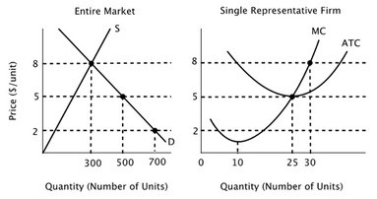 The long-run market equilibrium quantity in this industry is:
The long-run market equilibrium quantity in this industry is:
A)300.
B)500.
C)700.
D)more than 700.
 The long-run market equilibrium quantity in this industry is:
The long-run market equilibrium quantity in this industry is:A)300.
B)500.
C)700.
D)more than 700.

Unlock Deck
Unlock for access to all 159 flashcards in this deck.
Unlock Deck
k this deck
42
Suppose all firms in a perfectly competitive industry are earning an economic profit. One would expect that, over time, the number of firms in the industry will ________ and the market price will ________.
A)rise; fall
B)fall; rise
C)rise; rise
D)rise; stay the same
A)rise; fall
B)fall; rise
C)rise; rise
D)rise; stay the same

Unlock Deck
Unlock for access to all 159 flashcards in this deck.
Unlock Deck
k this deck
43
If the firms in a market are earning an economic profit, then, in the long run, the market ________ curve will shift to the ________.
A)demand; right
B)supply; right
C)supply; left
D)demand; left
A)demand; right
B)supply; right
C)supply; left
D)demand; left

Unlock Deck
Unlock for access to all 159 flashcards in this deck.
Unlock Deck
k this deck
44
One difference between the long run and the short run in a perfectly competitive industry is that:
A)economic profit in the long run is always greater than it is in the short run.
B)economic profit in the short run is always greater than it is in the long run.
C)firms necessarily earn zero economic profit in the long run but may earn positive or negative economic profit in the short run.
D)firms necessarily earn positive economic profit in the long run but may earn positive or negative economic profit in the short run.
A)economic profit in the long run is always greater than it is in the short run.
B)economic profit in the short run is always greater than it is in the long run.
C)firms necessarily earn zero economic profit in the long run but may earn positive or negative economic profit in the short run.
D)firms necessarily earn positive economic profit in the long run but may earn positive or negative economic profit in the short run.

Unlock Deck
Unlock for access to all 159 flashcards in this deck.
Unlock Deck
k this deck
45
In perfectly competitive markets, an implication of entry and exit in response to economic profit and loss is that:
A)firms must earn positive economic profit in the long run.
B)firms will produce the quantity that minimizes average variable costs in the short run.
C)firms will produce the quantity that minimizes average total costs in the long run.
D)market demand is completely elastic.
A)firms must earn positive economic profit in the long run.
B)firms will produce the quantity that minimizes average variable costs in the short run.
C)firms will produce the quantity that minimizes average total costs in the long run.
D)market demand is completely elastic.

Unlock Deck
Unlock for access to all 159 flashcards in this deck.
Unlock Deck
k this deck
46
Assume that all firms in this industry have identical cost curves, and that the market is perfectly competitive.  If the market supply curve is given by S3, then in the long run firms will:
If the market supply curve is given by S3, then in the long run firms will:
A)exit the market, leading the market supply curve to shift back to S2.
B)exit the market, leading the market supply curve to shift back to S1.
C)enter the market, leading the market supply curve to shift back to S2.
D)neither enter nor exit the market, so the market supply curve will remain at S3.
 If the market supply curve is given by S3, then in the long run firms will:
If the market supply curve is given by S3, then in the long run firms will:A)exit the market, leading the market supply curve to shift back to S2.
B)exit the market, leading the market supply curve to shift back to S1.
C)enter the market, leading the market supply curve to shift back to S2.
D)neither enter nor exit the market, so the market supply curve will remain at S3.

Unlock Deck
Unlock for access to all 159 flashcards in this deck.
Unlock Deck
k this deck
47
Entry into a perfectly competitive industry occurs whenever:
A)accounting profit is equal to zero.
B)accounting profit is greater than zero.
C)economic profit is greater than zero.
D)economic profit is equal to zero.
A)accounting profit is equal to zero.
B)accounting profit is greater than zero.
C)economic profit is greater than zero.
D)economic profit is equal to zero.

Unlock Deck
Unlock for access to all 159 flashcards in this deck.
Unlock Deck
k this deck
48
Suppose farmers in a given market can either grow soy beans or corn on their land. In addition, suppose an increase in the demand for corn causes the price of corn to increase. All else equal, an increase in the price of corn creates an incentive for farmers to:
A)switch away from growing corn and into growing soy beans.
B)switch away from growing soy beans and into growing corn.
C)grow less corn, but not change their production of soy beans.
D)grow more corn, but not change their production of soy beans.
A)switch away from growing corn and into growing soy beans.
B)switch away from growing soy beans and into growing corn.
C)grow less corn, but not change their production of soy beans.
D)grow more corn, but not change their production of soy beans.

Unlock Deck
Unlock for access to all 159 flashcards in this deck.
Unlock Deck
k this deck
49
Generally, ________ motivates firms to enter an industry, while ________ motivates firms to exit an industry.
A)economic profit; economic loss
B)accounting profit; accounting loss
C)accounting profit; economic loss
D)economic profit; accounting loss
A)economic profit; economic loss
B)accounting profit; accounting loss
C)accounting profit; economic loss
D)economic profit; accounting loss

Unlock Deck
Unlock for access to all 159 flashcards in this deck.
Unlock Deck
k this deck
50
In an industry with free entry and exit, positive economic profit:
A)indicates a market failure.
B)can never occur.
C)cannot be sustained indefinitely.
D)can be sustained indefinitely.
A)indicates a market failure.
B)can never occur.
C)cannot be sustained indefinitely.
D)can be sustained indefinitely.

Unlock Deck
Unlock for access to all 159 flashcards in this deck.
Unlock Deck
k this deck
51
Assume that all firms in this industry have identical cost curves, and that the market is perfectly competitive. 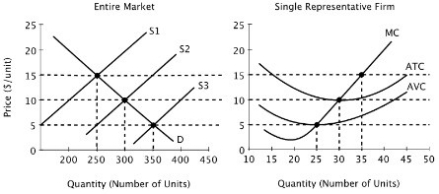 The firm depicted in the graph on the right faces a demand curve that is:
The firm depicted in the graph on the right faces a demand curve that is:
A)horizontal at the market price.
B)less than the market demand curve.
C)the same as the marginal cost curve.
D)the same as the market demand curve.
 The firm depicted in the graph on the right faces a demand curve that is:
The firm depicted in the graph on the right faces a demand curve that is:A)horizontal at the market price.
B)less than the market demand curve.
C)the same as the marginal cost curve.
D)the same as the market demand curve.

Unlock Deck
Unlock for access to all 159 flashcards in this deck.
Unlock Deck
k this deck
52
Assume that all firms in this industry have identical cost curves, and that the market is perfectly competitive. 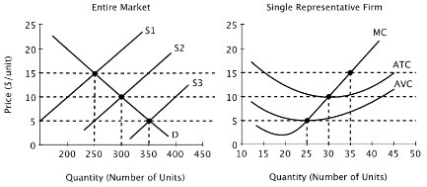 If the market supply curve is given by S1, then in the long run firms will:
If the market supply curve is given by S1, then in the long run firms will:
A)enter the market, leading the market supply curve to shift out to S3.
B)enter the market, leading the market supply curve to shift out to S2.
C)exit the market, leading the market supply curve to shift out to S2.
D)neither enter nor exit the market, so the market supply curve will remain at S1.
 If the market supply curve is given by S1, then in the long run firms will:
If the market supply curve is given by S1, then in the long run firms will:A)enter the market, leading the market supply curve to shift out to S3.
B)enter the market, leading the market supply curve to shift out to S2.
C)exit the market, leading the market supply curve to shift out to S2.
D)neither enter nor exit the market, so the market supply curve will remain at S1.

Unlock Deck
Unlock for access to all 159 flashcards in this deck.
Unlock Deck
k this deck
53
Assume that all firms in this industry have identical cost curves, and that the market is perfectly competitive. 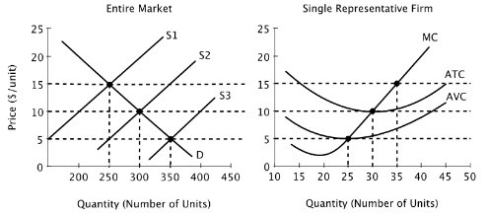 In the long run, there will be ________ firms in this market.
In the long run, there will be ________ firms in this market.
A)10
B)15
C)25
D)50
 In the long run, there will be ________ firms in this market.
In the long run, there will be ________ firms in this market.A)10
B)15
C)25
D)50

Unlock Deck
Unlock for access to all 159 flashcards in this deck.
Unlock Deck
k this deck
54
Assume that all firms in this industry have identical cost curves, and that the market is perfectly competitive.
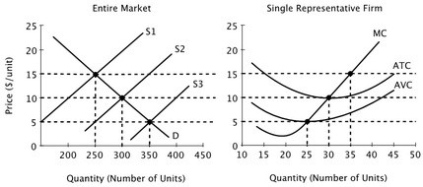 The long-run equilibrium price in this industry is:
The long-run equilibrium price in this industry is:
A)$15
B)$10
C)$5
D)$0
 The long-run equilibrium price in this industry is:
The long-run equilibrium price in this industry is:A)$15
B)$10
C)$5
D)$0

Unlock Deck
Unlock for access to all 159 flashcards in this deck.
Unlock Deck
k this deck
55
Assume that all firms in this industry have identical cost curves, and that the market is perfectly competitive. 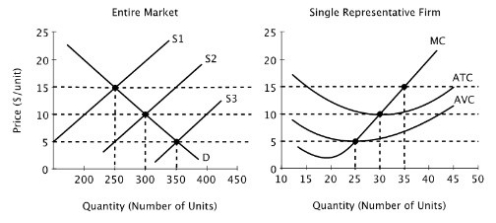 In the short run, firms in this market will shut down if the market price is:
In the short run, firms in this market will shut down if the market price is:
A)greater than $10.
B)less than $15.
C)less than $10.
D)less than $5
 In the short run, firms in this market will shut down if the market price is:
In the short run, firms in this market will shut down if the market price is:A)greater than $10.
B)less than $15.
C)less than $10.
D)less than $5

Unlock Deck
Unlock for access to all 159 flashcards in this deck.
Unlock Deck
k this deck
56
In the long run, in a perfectly competitive industry:
A)economic profit tends to persist.
B)the number of firms in the industry will increase.
C)economic loss tends to persist.
D)economic profit and loss are driven to zero by entry and exit.
A)economic profit tends to persist.
B)the number of firms in the industry will increase.
C)economic loss tends to persist.
D)economic profit and loss are driven to zero by entry and exit.

Unlock Deck
Unlock for access to all 159 flashcards in this deck.
Unlock Deck
k this deck
57
If all firms in a perfectly competitive industry are earning a normal profit, then:
A)new firms will enter the industry.
B)existing firms will exit the industry.
C)there is no incentive for firms to enter or exit the industry.
D)the market supply curve will shift to the left.
A)new firms will enter the industry.
B)existing firms will exit the industry.
C)there is no incentive for firms to enter or exit the industry.
D)the market supply curve will shift to the left.

Unlock Deck
Unlock for access to all 159 flashcards in this deck.
Unlock Deck
k this deck
58
Suppose farmers in a given market can either grow soy beans or corn on their land. In addition, suppose an increase in the demand for corn causes the price of corn to increase. As a result of the increase in the price of corn, farmers who were already growing corn will earn an:
A)economic loss in the short run.
B)economic profit in the long run.
C)economic profit in the short run.
D)economic loss in the long run.
A)economic loss in the short run.
B)economic profit in the long run.
C)economic profit in the short run.
D)economic loss in the long run.

Unlock Deck
Unlock for access to all 159 flashcards in this deck.
Unlock Deck
k this deck
59
Suppose farmers in a given market can either grow soy beans or corn on their land. In addition, suppose an increase in the demand for corn causes the price of corn to increase. In the long run, this increase in the demand for corn is likely to ________ the price of soy beans.
A)lead to an increase in
B)lead to a decrease in
C)have no effect on
D)have an ambiguous effect on
A)lead to an increase in
B)lead to a decrease in
C)have no effect on
D)have an ambiguous effect on

Unlock Deck
Unlock for access to all 159 flashcards in this deck.
Unlock Deck
k this deck
60
If all firms in a perfectly competitive industry are experiencing economic losses, then:
A)some firms will exit the industry, until economic profit is positive.
B)some firms will exit the industry, until accounting profit equals zero.
C)all existing firms will stay in the industry, hoping for better times.
D)some firms will exit the industry, until economic profit equals zero.
A)some firms will exit the industry, until economic profit is positive.
B)some firms will exit the industry, until accounting profit equals zero.
C)all existing firms will stay in the industry, hoping for better times.
D)some firms will exit the industry, until economic profit equals zero.

Unlock Deck
Unlock for access to all 159 flashcards in this deck.
Unlock Deck
k this deck
61
E-commerce and an internet presence are important to many firms, requiring employees with specialized skills that are in short supply. The invisible hand solves the employment problem by:
A)encouraging the government to set up training programs to provide workers with the necessary skills.
B)giving workers an incentive to acquire the necessary skills on their own in order to receive higher wages.
C)providing free internet access.
D)discouraging firms from using of new technologies such as the internet.
A)encouraging the government to set up training programs to provide workers with the necessary skills.
B)giving workers an incentive to acquire the necessary skills on their own in order to receive higher wages.
C)providing free internet access.
D)discouraging firms from using of new technologies such as the internet.

Unlock Deck
Unlock for access to all 159 flashcards in this deck.
Unlock Deck
k this deck
62
Assume that all firms in this industry have identical cost curves, and that the market is perfectly competitive. 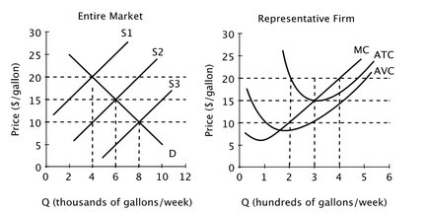 If the market supply curve is given by S3, then what will happen to the market supply curve in the long run?
If the market supply curve is given by S3, then what will happen to the market supply curve in the long run?
A)It will stay at S3, but the quantity supplied will increase.
B)It will shift to S2.
C)It will shift to S1.
D)It will stay at S3, but the quantity supplied will decrease.
 If the market supply curve is given by S3, then what will happen to the market supply curve in the long run?
If the market supply curve is given by S3, then what will happen to the market supply curve in the long run?A)It will stay at S3, but the quantity supplied will increase.
B)It will shift to S2.
C)It will shift to S1.
D)It will stay at S3, but the quantity supplied will decrease.

Unlock Deck
Unlock for access to all 159 flashcards in this deck.
Unlock Deck
k this deck
63
The figure below depicts the short-run market equilibrium in a perfectly competitive market and the cost curves for a representative firm in that market. Assume that all firms in this market have identical cost curves. 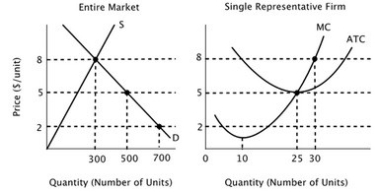 Given that the current equilibrium price is $8, what will happen to the number of firms in this market in the long run?
Given that the current equilibrium price is $8, what will happen to the number of firms in this market in the long run?
A)The number of firms in the market will not change unless there is a change in either demand or in the cost of production.
B)The number of firms in the market will fall as firms exit the market in response to negative economic profit.
C)It is impossible to determine whether the number of firms in this market will rise or fall.
D)The number of firms in the market will rise as firms enter the market in response to positive economic profit.
 Given that the current equilibrium price is $8, what will happen to the number of firms in this market in the long run?
Given that the current equilibrium price is $8, what will happen to the number of firms in this market in the long run?A)The number of firms in the market will not change unless there is a change in either demand or in the cost of production.
B)The number of firms in the market will fall as firms exit the market in response to negative economic profit.
C)It is impossible to determine whether the number of firms in this market will rise or fall.
D)The number of firms in the market will rise as firms enter the market in response to positive economic profit.

Unlock Deck
Unlock for access to all 159 flashcards in this deck.
Unlock Deck
k this deck
64
According to the theory of the invisible hand, if buyers and sellers are free to pursue their own self-interest, the result often will be:
A)an incomplete allocation of resources.
B)the exploitation of productive resources.
C)an equitable allocation of resources.
D)an efficient allocation of resources.
A)an incomplete allocation of resources.
B)the exploitation of productive resources.
C)an equitable allocation of resources.
D)an efficient allocation of resources.

Unlock Deck
Unlock for access to all 159 flashcards in this deck.
Unlock Deck
k this deck
65
Which of the following best describes how a perfectly competitive industry would respond to a sudden increase in popularity of the product? The market demand curve would shift to the right, leading to:
A)a higher equilibrium price in the short run and entry into the market in the long run.
B)a higher equilibrium price in the short run and a permanent increase in economic profit.
C)no change in the short-run equilibrium price, and a higher long-run equilibrium quantity.
D)a lower short-run equilibrium price due to the entry of firms into the market.
A)a higher equilibrium price in the short run and entry into the market in the long run.
B)a higher equilibrium price in the short run and a permanent increase in economic profit.
C)no change in the short-run equilibrium price, and a higher long-run equilibrium quantity.
D)a lower short-run equilibrium price due to the entry of firms into the market.

Unlock Deck
Unlock for access to all 159 flashcards in this deck.
Unlock Deck
k this deck
66
One assumption of the perfectly competitive model is free entry and exit. This assumption most directly leads to the implication that:
A)firms will have to spend money on advertising.
B)positive economic profit is only possible in the short run.
C)firms will compete on the basis of better service rather than lower prices.
D)a long-run equilibrium cannot be achieved.
A)firms will have to spend money on advertising.
B)positive economic profit is only possible in the short run.
C)firms will compete on the basis of better service rather than lower prices.
D)a long-run equilibrium cannot be achieved.

Unlock Deck
Unlock for access to all 159 flashcards in this deck.
Unlock Deck
k this deck
67
Assume that all firms in this industry have identical cost curves, and that the market is perfectly competitive.  If the market supply curve is given by S3, then we would expect firms to:
If the market supply curve is given by S3, then we would expect firms to:
A)exit the market in the long run.
B)enter the market in the long run.
C)neither exit nor enter the market in the long run.
D)shut down in the short run.
 If the market supply curve is given by S3, then we would expect firms to:
If the market supply curve is given by S3, then we would expect firms to:A)exit the market in the long run.
B)enter the market in the long run.
C)neither exit nor enter the market in the long run.
D)shut down in the short run.

Unlock Deck
Unlock for access to all 159 flashcards in this deck.
Unlock Deck
k this deck
68
Assume that all firms in this industry have identical cost curves, and that the market is perfectly competitive. 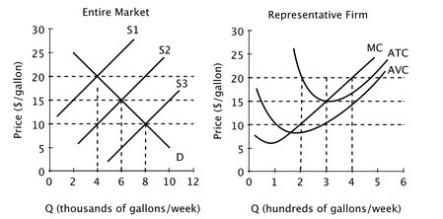 In the long run, how much profit will each firm in this industry earn each week?
In the long run, how much profit will each firm in this industry earn each week?
A)$0
B)$1,000
C)$1,500
D)$2,000
 In the long run, how much profit will each firm in this industry earn each week?
In the long run, how much profit will each firm in this industry earn each week?A)$0
B)$1,000
C)$1,500
D)$2,000

Unlock Deck
Unlock for access to all 159 flashcards in this deck.
Unlock Deck
k this deck
69
The figure below depicts the short-run market equilibrium in a perfectly competitive market and the cost curves for a representative firm in that market. Assume that all firms in this market have identical cost curves. 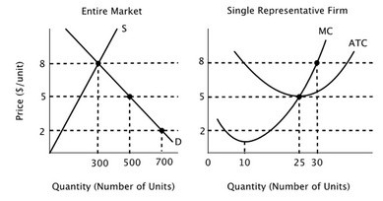 A starting assumption about this industry was that all of the firms in the market had identical cost curves. This assumption is:
A starting assumption about this industry was that all of the firms in the market had identical cost curves. This assumption is:
A)unrealistic because each firm is unique.
B)realistic because any cost-saving innovation adopted by one firm will be quickly adopted by others.
C)unrealistic because firms closely guard the details of their production processes.
D)realistic because firms rarely seek out cost-saving innovations.
 A starting assumption about this industry was that all of the firms in the market had identical cost curves. This assumption is:
A starting assumption about this industry was that all of the firms in the market had identical cost curves. This assumption is:A)unrealistic because each firm is unique.
B)realistic because any cost-saving innovation adopted by one firm will be quickly adopted by others.
C)unrealistic because firms closely guard the details of their production processes.
D)realistic because firms rarely seek out cost-saving innovations.

Unlock Deck
Unlock for access to all 159 flashcards in this deck.
Unlock Deck
k this deck
70
Assume that all firms in this industry have identical cost curves, and that the market is perfectly competitive. 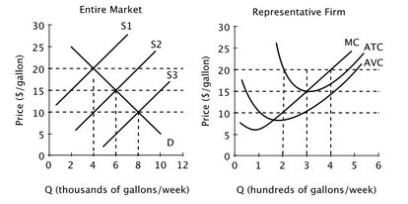 If S3 is the market supply curve, then in the short run, the profit-maximizing level of output for a single firm in this market is ________ gallons per week.
If S3 is the market supply curve, then in the short run, the profit-maximizing level of output for a single firm in this market is ________ gallons per week.
A)0
B)200
C)400
D)8000
 If S3 is the market supply curve, then in the short run, the profit-maximizing level of output for a single firm in this market is ________ gallons per week.
If S3 is the market supply curve, then in the short run, the profit-maximizing level of output for a single firm in this market is ________ gallons per week.A)0
B)200
C)400
D)8000

Unlock Deck
Unlock for access to all 159 flashcards in this deck.
Unlock Deck
k this deck
71
In a free market economy, the decisions of buyers and sellers are:
A)random.
B)motivated by custom and tradition.
C)coordinated by the government.
D)guided by prices.
A)random.
B)motivated by custom and tradition.
C)coordinated by the government.
D)guided by prices.

Unlock Deck
Unlock for access to all 159 flashcards in this deck.
Unlock Deck
k this deck
72
Barriers to entry are forces that:
A)limit consumers from purchasing new products.
B)limit new firms from joining an industry.
C)promote a more efficient allocation of resources across the economy.
D)limit the government from intervening in markets.
A)limit consumers from purchasing new products.
B)limit new firms from joining an industry.
C)promote a more efficient allocation of resources across the economy.
D)limit the government from intervening in markets.

Unlock Deck
Unlock for access to all 159 flashcards in this deck.
Unlock Deck
k this deck
73
The allocative function of price cannot operate unless there is:
A)a significant barrier to entry.
B)both free entry and free exit.
C)either free entry or free exit.
D)neither free entry no free exit.
A)a significant barrier to entry.
B)both free entry and free exit.
C)either free entry or free exit.
D)neither free entry no free exit.

Unlock Deck
Unlock for access to all 159 flashcards in this deck.
Unlock Deck
k this deck
74
Assume that all firms in this industry have identical cost curves, and that the market is perfectly competitive. 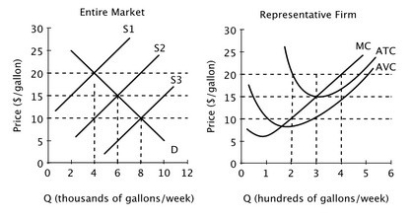 If S3 is the market supply curve, then each firm in this market will earn an economic loss of ________ per week.
If S3 is the market supply curve, then each firm in this market will earn an economic loss of ________ per week.
A)$1,000
B)$1,500
C)$2,000
D)$3,000
 If S3 is the market supply curve, then each firm in this market will earn an economic loss of ________ per week.
If S3 is the market supply curve, then each firm in this market will earn an economic loss of ________ per week.A)$1,000
B)$1,500
C)$2,000
D)$3,000

Unlock Deck
Unlock for access to all 159 flashcards in this deck.
Unlock Deck
k this deck
75
Assume that all firms in this industry have identical cost curves, and that the market is perfectly competitive. 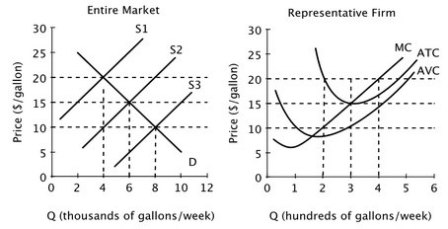 In the long run, the equilibrium price will be ________ per gallon, and each firm's profit-maximizing quantity will be ________ gallons per week.
In the long run, the equilibrium price will be ________ per gallon, and each firm's profit-maximizing quantity will be ________ gallons per week.
A)$20; 400
B)$15; 6,000
C)$15; 300
D)$20; 4,000
 In the long run, the equilibrium price will be ________ per gallon, and each firm's profit-maximizing quantity will be ________ gallons per week.
In the long run, the equilibrium price will be ________ per gallon, and each firm's profit-maximizing quantity will be ________ gallons per week.A)$20; 400
B)$15; 6,000
C)$15; 300
D)$20; 4,000

Unlock Deck
Unlock for access to all 159 flashcards in this deck.
Unlock Deck
k this deck
76
The figure below depicts the short-run market equilibrium in a perfectly competitive market and the cost curves for a representative firm in that market. Assume that all firms in this market have identical cost curves. 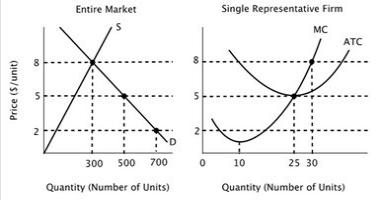 In the long run equilibrium in this market:
In the long run equilibrium in this market:
A)price will equal $5, and there will be 20 firms in the industry.
B)price will equal $5, and there will be 10 firms in the industry.
C)price will equal $8, and there will be 20 firms in the industry.
D)price will equal $5 and total output will equal 500 units, but there is not enough information to determine how many firms will be in the industry.
 In the long run equilibrium in this market:
In the long run equilibrium in this market:A)price will equal $5, and there will be 20 firms in the industry.
B)price will equal $5, and there will be 10 firms in the industry.
C)price will equal $8, and there will be 20 firms in the industry.
D)price will equal $5 and total output will equal 500 units, but there is not enough information to determine how many firms will be in the industry.

Unlock Deck
Unlock for access to all 159 flashcards in this deck.
Unlock Deck
k this deck
77
Free entry and exit of firms is a characteristic of:
A)all industries in the U. S. economy.
B)perfectly competitive industries.
C)centralized economies.
D)industries in which firms are earning positive economic profit.
A)all industries in the U. S. economy.
B)perfectly competitive industries.
C)centralized economies.
D)industries in which firms are earning positive economic profit.

Unlock Deck
Unlock for access to all 159 flashcards in this deck.
Unlock Deck
k this deck
78
Some people have argued that the government should provide free medical care to everyone. Under this system:
A)the price of medical care will allocate resources efficiently.
B)the price of medical care will ration resources efficiently.
C)prices will not ration medical care so there will be no scarcity.
D)prices will not ration medical care so some other rationing method will be used.
A)the price of medical care will allocate resources efficiently.
B)the price of medical care will ration resources efficiently.
C)prices will not ration medical care so there will be no scarcity.
D)prices will not ration medical care so some other rationing method will be used.

Unlock Deck
Unlock for access to all 159 flashcards in this deck.
Unlock Deck
k this deck
79
In a market with barriers to entry:
A)firms will earn zero economic profit in the long run.
B)economic profit will not fall to zero in the long run.
C)prices will direct productive resources toward underserved markets.
D)the implications of Adam Smith's theory of the invisible hand can be expected to hold.
A)firms will earn zero economic profit in the long run.
B)economic profit will not fall to zero in the long run.
C)prices will direct productive resources toward underserved markets.
D)the implications of Adam Smith's theory of the invisible hand can be expected to hold.

Unlock Deck
Unlock for access to all 159 flashcards in this deck.
Unlock Deck
k this deck
80
If resources are misallocated in a perfectly competitive market, then, in the long run, profit opportunities will:
A)bring about a more efficient allocation of resources.
B)bring about a less efficient allocation of resources.
C)not bring about a reallocation of resources unless there is government regulation.
D)not bring about a reallocation of resources unless firms are subsidized.
A)bring about a more efficient allocation of resources.
B)bring about a less efficient allocation of resources.
C)not bring about a reallocation of resources unless there is government regulation.
D)not bring about a reallocation of resources unless firms are subsidized.

Unlock Deck
Unlock for access to all 159 flashcards in this deck.
Unlock Deck
k this deck



